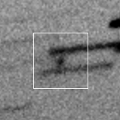
|
It brightened very rapidly. Now it is 11.2 mag (Aug. 10, Ken-ichi Kadota). It will brighten up to 8.5 mag from September to October. But the condition is bad in this apparition. In the Southern Hemisphere, it stays observable after this while the comet will be fading. But it stays locating low. It is not observable after this in the Northern Hemisphere.
Date(TT) R.A. (2000) Decl. Delta r Elong. m1 Best Time(A, h)
Aug. 21 8 20.41 10 52.1 1.863 1.031 24 9.4 3:53 (257, 0)
Aug. 28 8 42.81 5 25.4 1.835 1.026 25 9.1 4:00 (263, 0)
|
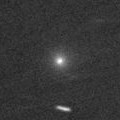
|
It was observed at 9-10 mag from late July to early August. Now it is not observable. It will appear in the morning sky in December, but it will be fainter than 15 mag at that time.
Date(TT) R.A. (2000) Decl. Delta r Elong. m1 Best Time(A, h)
Aug. 21 9 48.64 26 15.8 1.739 0.799 14 9.2 3:53 (232, -6)
Aug. 28 10 28.21 22 43.9 1.786 0.833 12 9.5 20:00 (125, -9)
|
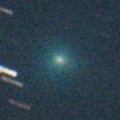
|
It brightened very rapidly. Now it is very bright as 11.1 mag (Aug. 6, Carlos Labordena). It stays 10 mag until August. It stays observable in the morning sky for a long time.
Date(TT) R.A. (2000) Decl. Delta r Elong. m1 Best Time(A, h)
Aug. 21 6 16.19 26 29.9 1.375 1.136 54 10.4 3:53 (259, 33)
Aug. 28 6 39.56 26 50.4 1.408 1.186 55 10.8 4:00 (260, 36)
|
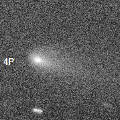
|
Now it is 11.3 mag (Aug. 18, Osamu Miyazaki). It stays observable at 10-11 mag in excellent condition from summer to autumn.
Date(TT) R.A. (2000) Decl. Delta r Elong. m1 Best Time(A, h)
Aug. 21 4 19.94 18 57.4 1.437 1.630 81 10.7 3:53 (286, 53)
Aug. 28 4 39.22 18 55.6 1.386 1.623 83 10.6 4:00 (290, 56)
|
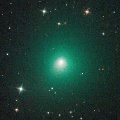
|
Now it is very bright as 10.9 mag (Aug. 13, Chris Wyatt). It will be fading after this. In the Northern Hemisphere, it will be getting lower gradually in the evening. In the Southern Hemisphere, it stays observable in good condition for a while.
Date(TT) R.A. (2000) Decl. Delta r Elong. m1 Best Time(A, h)
Aug. 21 14 58.38 -11 40.5 2.081 2.112 77 10.8 20:11 ( 53, 25)
Aug. 28 15 10.61 -14 9.6 2.167 2.132 74 10.9 20:00 ( 52, 22)
|
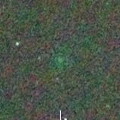
|
It brightened up to 4 mag in major outburst in 2016. Now it is very bright as 10.5 mag (Aug. 8, Rob Kaufman). In the Southern Hemisphere, it stays locating low in the evening sky until October. In the Northern Hemisphere, it stays locating extremely low.
Date(TT) R.A. (2000) Decl. Delta r Elong. m1 Best Time(A, h)
Aug. 21 12 32.15 0 21.3 1.734 1.150 39 10.9 20:11 ( 87, 5)
Aug. 28 13 0.61 -1 52.9 1.777 1.199 40 11.2 20:00 ( 83, 6)
|
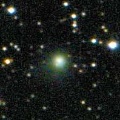
|
Now it is 11.6 mag (Aug. 18, Osamu Miyazaki). It will brighten up to 10 mag in winter in 2022. In the Northern Hemisphere, it stays observable in good condition for a long time. In the Southern Hemisphere, it is not observable until November.
Date(TT) R.A. (2000) Decl. Delta r Elong. m1 Best Time(A, h)
Aug. 21 6 41.33 46 20.1 4.287 3.780 53 11.7 3:53 (234, 36)
Aug. 28 6 51.31 45 49.2 4.195 3.759 58 11.7 4:00 (236, 40)
|
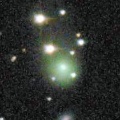
|
Now it is 13.0 mag (Aug. 13, Chris Wyatt). It is expected to be observable at 5-6 mag for a long time from 2022 to 2023. In the Northern Hemisphere, it is not observable at the high light from 2022 autumn to 2023 summer. In the Southern Hemisphere, it stays low for a while. But it will be observable in good condition at the high light.
Date(TT) R.A. (2000) Decl. Delta r Elong. m1 Best Time(A, h)
Aug. 21 16 59.64 34 52.4 5.377 5.555 94 12.1 20:11 ( 94, 75)
Aug. 28 16 57.92 33 27.4 5.381 5.495 91 12.1 20:00 ( 91, 71)
|
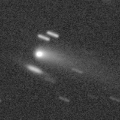
|
Now it is 13.3 mag (Aug. 12, Michael Jager). It will brighten up to 9 mag, and will be observable in good condition in winter.
Date(TT) R.A. (2000) Decl. Delta r Elong. m1 Best Time(A, h)
Aug. 21 2 29.19 10 10.9 0.824 1.503 109 12.7 3:53 (338, 64)
Aug. 28 2 50.20 12 3.0 0.750 1.457 110 12.3 4:00 (345, 66)
|
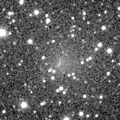
|
Now it is 13.4 mag (July 29, Thomas Lehmann). It will brighten very rapidly, and it will be observable at 10 mag in good condition from October to December. In the Northern Hemisphere, it locates somewhat low at the high light.
Date(TT) R.A. (2000) Decl. Delta r Elong. m1 Best Time(A, h)
Aug. 21 16 45.65 -8 2.5 0.759 1.392 102 13.0 20:11 ( 29, 42)
Aug. 28 17 0.24 -11 54.4 0.771 1.376 100 12.5 20:00 ( 27, 39)
|
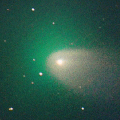
|
It brightened up to 9.7 mag in June (June 4, Michael Jager). Now it is fading. It has already faded down to 12.8 mag (Aug. 13, Chris Wyatt). In the Southern Hemisphere, it stays observable in excellent condition for a long time. In the Northern Hemisphere, it becomes extremely low after this.
Date(TT) R.A. (2000) Decl. Delta r Elong. m1 Best Time(A, h)
Aug. 21 23 58.30 -51 30.8 0.723 1.601 134 12.6 2:02 ( 0, 4)
Aug. 28 23 50.64 -51 59.3 0.778 1.651 134 12.9 1:27 ( 0, 3)
|
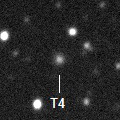
|
Now it is 14.6 mag (July 12, Chris Wyatt). It is expected to brighten up to 11.5 mag in 2022. In the Southern Hemisphere, it stas observable in good condition for a long time, although it becomes extremely low temporarily from August to September. In the Northern Hemisphere, it is not observable until November.
Date(TT) R.A. (2000) Decl. Delta r Elong. m1 Best Time(A, h)
Aug. 21 9 56.46 -22 24.9 5.675 4.877 34 13.7 3:53 (273,-38)
Aug. 28 10 4.39 -22 35.0 5.667 4.849 32 13.6 4:00 (276,-33)
|
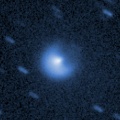
|
Now it is faint as 16.6 mag (Aug. 19, Jean-Francois Soulier).
Date(TT) R.A. (2000) Decl. Delta r Elong. m1 Best Time(A, h)
Aug. 21 4 46.78 30 50.0 6.107 5.906 73 13.7 3:53 (264, 53)
Aug. 28 4 49.99 31 2.4 6.002 5.908 79 13.7 4:00 (267, 59)
|

|
Now it is 14.5 mag (Aug. 10, Chris Wyatt). It stays 13-14 mag from 2020 to 2021. It will be observable in good condition after this in the Southern Hemisphere. It locates low in the Northern Hemisphere.
Date(TT) R.A. (2000) Decl. Delta r Elong. m1 Best Time(A, h)
Aug. 21 18 43.48 -35 35.5 2.269 3.020 129 14.2 20:44 ( 0, 19)
Aug. 28 18 43.76 -35 35.7 2.355 3.032 123 14.3 20:17 ( 0, 19)
|
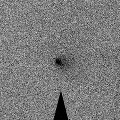
|
It brightened up to 10.1 mag in spring (Apr. 10, Marco Goiato). Now it is fading. It has already faded down to 14.8 mag (Aug. 10, Chris Wyatt). It stays observable in good condition for a long time after this while the comet will fading.
Date(TT) R.A. (2000) Decl. Delta r Elong. m1 Best Time(A, h)
Aug. 21 4 27.82 8 59.6 1.931 2.042 81 14.2 3:53 (296, 46)
Aug. 28 4 35.85 8 52.3 1.895 2.085 86 14.3 4:00 (303, 50)
|
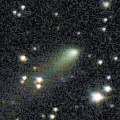
|
Now it is 14.0 mag (Aug. 3, Hirohisa Sato). It stays 14 mag until October, and it is observable in good condition. It locates somewhat low in the Southern Hemisphere.
Date(TT) R.A. (2000) Decl. Delta r Elong. m1 Best Time(A, h)
Aug. 21 17 6.25 29 8.3 1.962 2.330 98 14.3 20:11 ( 71, 75)
Aug. 28 16 49.80 27 30.4 2.074 2.318 90 14.4 20:00 ( 77, 68)
|
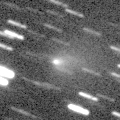
|
Outburst occured in early August. Now it is very bright as 14.5 mag (Aug. 13, Michael Jager). In the Northern Hemisphere, it stays observable in good condition. In the Southern Hemipsphere, it stays locating extremely low after this.
Date(TT) R.A. (2000) Decl. Delta r Elong. m1 Best Time(A, h)
Aug. 21 4 58.54 40 46.7 2.625 2.488 71 14.4 3:53 (247, 53)
Aug. 28 5 9.92 41 35.5 2.574 2.515 75 14.6 4:00 (246, 57)
|

|
Now it is 14.3 mag (Aug. 10, Chris Wyatt). It will be getting lower rapidly after this, and it will be unobservable in September.
Date(TT) R.A. (2000) Decl. Delta r Elong. m1 Best Time(A, h)
Aug. 21 13 41.70 -5 21.5 3.986 3.551 57 14.5 20:11 ( 72, 15)
Aug. 28 13 42.94 -4 49.2 4.118 3.573 51 14.6 20:00 ( 75, 12)
|
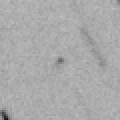
|
Now it is 17.0 mag (Aug. 4, Slooh.com Chile Observatory, La Dehesa). It will brighten rapidly up to 9 mag in winter. It will be observable in good condition.
Date(TT) R.A. (2000) Decl. Delta r Elong. m1 Best Time(A, h)
Aug. 21 0 16.92 -53 0.7 1.418 2.217 130 14.9 2:21 ( 0, 2)
Aug. 28 0 13.23 -54 51.0 1.370 2.165 130 14.6 1:49 ( 0, 0)
|
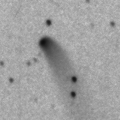
|
Now it is 14.4 mag (Aug. 10, Chris Wyatt). It stays 14-15 mag until the end of 2021. In the Southern Hemisphere, it stays observable in good condition for a long time. It locates low in the Northern Hemisphere.
Date(TT) R.A. (2000) Decl. Delta r Elong. m1 Best Time(A, h)
Aug. 21 23 13.18 -33 25.8 3.574 4.499 153 14.6 1:17 ( 0, 22)
Aug. 28 23 6.59 -33 3.2 3.580 4.515 154 14.6 0:43 ( 0, 22)
|
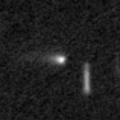
|
Now it is 16.2 mag (July 30, Thomas Lehmann). It will approach to Earth down to 0.2 a.u. in December, and it is expected to brighten up to 4 mag. In the Northern Hemisphere, it stays observable in good condition for a long time until December while the comet is brightening gradually, although it becomes extremely low temporarily in September. In the Southern Hemisphere, it is not observable until mid December.
Date(TT) R.A. (2000) Decl. Delta r Elong. m1 Best Time(A, h)
Aug. 21 10 46.77 42 59.6 3.226 2.432 32 14.9 20:11 (136, 10)
Aug. 28 10 51.46 41 58.9 3.124 2.337 32 14.7 20:00 (137, 8)
|
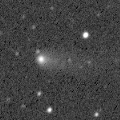
|
Now it is 14.9 mag (Aug. 10, Chris Wyatt). It was expected to brighten up to 13 mag from spring to summer. But actually, it is fainter than originally expected. It stays 14-15 mag until early autumn. In the Southern Hemisphere, it stays observable in good condition for a long time. In the Northern Hemisphere, it is not observable until July in 2022.
Date(TT) R.A. (2000) Decl. Delta r Elong. m1 Best Time(A, h)
Aug. 21 21 22.16 -87 6.6 3.239 3.636 105 14.8 23:25 ( 0,-32)
Aug. 28 20 54.83 -86 19.5 3.280 3.645 103 14.9 22:31 ( 0,-31)
|

|
Now it is 14.8 mag (Aug. 6, Hirohisa Sato). It stays at 14-15 mag for a long time from 2021 to 2022. It stays observable in good condition after this while brightening gradually.
Date(TT) R.A. (2000) Decl. Delta r Elong. m1 Best Time(A, h)
Aug. 21 16 25.27 -12 47.1 4.772 5.025 98 14.9 20:11 ( 32, 36)
Aug. 28 16 23.01 -13 46.2 4.888 5.020 91 15.0 20:00 ( 37, 33)
|
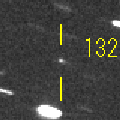
|
Now it is 17.2 mag (Aug. 5, F. Kugel, J.-G. Bosch). It will brighten very rapidly up to 14 mag, and it will be observable in excellent condition in autumn.
Date(TT) R.A. (2000) Decl. Delta r Elong. m1 Best Time(A, h)
Aug. 21 0 19.52 3 34.6 0.978 1.881 141 15.5 2:23 ( 0, 59)
Aug. 28 0 22.52 3 18.8 0.916 1.853 148 15.2 1:58 ( 0, 58)
|
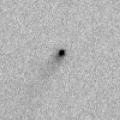
|
Now it is 15.6 mag (July 16, Ken-ichi Kadota). It stays 15 mag from summer to autumn. In the Northern Hemisphere, it stays observable in good condition for a long time. In the Southern Hemisphere, it will be getting lower gradually after this.
Date(TT) R.A. (2000) Decl. Delta r Elong. m1 Best Time(A, h)
Aug. 21 5 23.84 21 38.6 1.623 1.529 66 15.2 3:53 (271, 42)
Aug. 28 5 44.30 23 18.1 1.586 1.532 68 15.3 4:00 (271, 45)
|
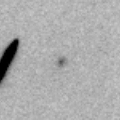
|
Now it is 15.5 mag (July 27, Ken-ichi Kadota). It will brighten rapidly up to 15 mag in autumn. It will be observable in excellent condition in the Northern Hemisphere. It locates somewhat low in the Southern Hemisphere.
Date(TT) R.A. (2000) Decl. Delta r Elong. m1 Best Time(A, h)
Aug. 21 4 35.18 18 23.2 1.558 1.672 78 15.5 3:53 (284, 50)
Aug. 28 4 52.96 19 40.3 1.503 1.665 80 15.4 4:00 (285, 54)
|
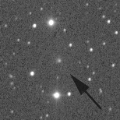
|
It brightened up to 14.2 mag in early summer (June 10, Thomas Lehmann). Now it is not observable. It will be fading after this. In the Northern Hemisphere, it will appear in the morning sky at 16 mag in October. In the Southern Hemisphere, it will never be observable again.
Date(TT) R.A. (2000) Decl. Delta r Elong. m1 Best Time(A, h)
Aug. 21 10 38.71 18 37.7 3.001 2.018 11 15.4 20:11 (118, -7)
Aug. 28 10 52.95 19 36.5 3.017 2.039 11 15.5 20:00 (119, -7)
|
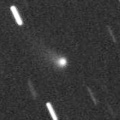
|
Now it is 15.4 mag (July 17, Thomas Lehmann). In the Northern Hemisphere, it stays observable at 15-16 mag for a long time from spring to early 2022. In the Southern Hemisphere, it is not observable until the end of 2021.
Date(TT) R.A. (2000) Decl. Delta r Elong. m1 Best Time(A, h)
Aug. 21 12 31.01 42 40.8 3.639 3.004 44 15.5 20:11 (125, 26)
Aug. 28 12 34.38 40 10.0 3.685 3.005 41 15.5 20:00 (124, 23)
|

|
Now it is 15.8 mag (July 30, Thomas Lehmann). It will brighten up to 13 mag in 2022. In 2021, it is observable at 14-15 mag in good condition.
Date(TT) R.A. (2000) Decl. Delta r Elong. m1 Best Time(A, h)
Aug. 21 13 38.75 -7 36.0 3.834 3.405 57 15.5 20:11 ( 71, 13)
Aug. 28 13 45.84 -8 29.3 3.901 3.391 53 15.5 20:00 ( 71, 11)
|
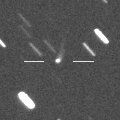
|
It will brighten up to 14.5 mag from spring to summer. In the Southern Hemisphere, it stays observable in excellent condition for a long time. In the Northern Hemisphere, it is not observable after this.
Date(TT) R.A. (2000) Decl. Delta r Elong. m1 Best Time(A, h)
Aug. 21 10 12.76 -56 5.6 3.151 2.932 68 15.6 20:11 ( 43,-44)
Aug. 28 10 27.32 -54 57.1 3.250 2.964 64 15.8 20:00 ( 44,-45)
|
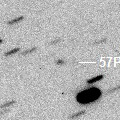
|
Now it is 16.7 mag (July 17, Ken-ichi Kadota). It will brighten up to 15.5 mag from summer to autumn. It stays observable for a long time.
Date(TT) R.A. (2000) Decl. Delta r Elong. m1 Best Time(A, h)
Aug. 21 15 54.34 -16 42.2 1.452 1.800 92 15.7 20:11 ( 38, 29)
Aug. 28 16 7.01 -17 26.6 1.495 1.782 88 15.6 20:00 ( 38, 28)
|

|
Now it is 16.3 mag (July 25, J. L. Virlichie, P. Traverse, H. Roy, J. P. Desgrees). It is expected to brighten up to 13 mag in 2022. In the Southern Hemisphere, it stays observable in good condition for a long time. In the Northern Hemisphere, it is not observable for a while.
Date(TT) R.A. (2000) Decl. Delta r Elong. m1 Best Time(A, h)
Aug. 21 12 4.82 -23 39.3 4.848 4.224 47 15.7 20:11 ( 71,-15)
Aug. 28 12 7.02 -24 23.5 4.875 4.182 42 15.7 20:00 ( 72,-18)
|
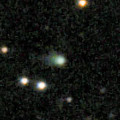
|
Now it is 16.1 mag (Aug. 2, ATLAS-HKO, Haleakala). It is expected to brighten up to 11 mag in 2023. In the Northern Hemisphere, it stays observable in good condition for a long time. It locates extremely low in the Southern Hemisphere.
Date(TT) R.A. (2000) Decl. Delta r Elong. m1 Best Time(A, h)
Aug. 21 16 13.65 44 10.4 6.193 6.168 83 15.8 20:11 (121, 66)
Aug. 28 16 10.49 43 1.2 6.209 6.124 80 15.8 20:00 (117, 62)
|
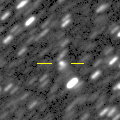
|
Now it is 15.7 mag (July 17, Toshiyuki Takahashi). It stays observable at 15-16 mag in good condition until autumn.
Date(TT) R.A. (2000) Decl. Delta r Elong. m1 Best Time(A, h)
Aug. 21 16 29.96 -12 20.4 4.589 4.863 99 15.8 20:11 ( 31, 37)
Aug. 28 16 30.85 -11 41.9 4.701 4.862 93 15.9 20:00 ( 36, 36)
|

|
It brightened up to 11.6 mag in winter (Feb. 18, Thomas Lehmann). Now it is fading. It has already faded down to 15.6 mag (July 29, Thomas Lehmann). In the Southern Hemisphere, it stays observable in good condition after this. In the Northern Hemisphere, it will never be observable after this.
Date(TT) R.A. (2000) Decl. Delta r Elong. m1 Best Time(A, h)
Aug. 21 5 30.09 -60 47.9 3.431 3.579 90 15.9 3:53 (335,-16)
Aug. 28 5 25.89 -62 20.5 3.468 3.644 91 15.9 4:00 (340,-14)
|
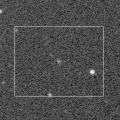
|
Now it is 16.1 mag (July 26, J. L. Virlichie, P. Traverse, H. Roy, J. P. Desgrees). It will brighten up to 12.5 mag in 2022 summer. In the Southern Hemisphere, it stays observable in excellent condition for a long time. In the Northern Hemisphere, it is not observable until August in 2022.
Date(TT) R.A. (2000) Decl. Delta r Elong. m1 Best Time(A, h)
Aug. 21 4 1.63 -58 60.0 4.464 4.749 100 16.0 3:53 (344, -8)
Aug. 28 4 0.03 -61 14.1 4.391 4.701 101 15.9 4:00 (349, -8)
|
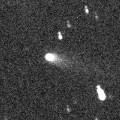
|
Now it is 15.4 mag (Aug. 12, Michael Jager). It stays observable at 16 mag in good condition until autumn.
Date(TT) R.A. (2000) Decl. Delta r Elong. m1 Best Time(A, h)
Aug. 21 23 21.51 -9 52.7 1.325 2.301 159 16.1 1:25 ( 0, 45)
Aug. 28 23 19.02 -11 6.6 1.303 2.298 166 16.0 0:55 ( 0, 44)
|
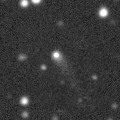
|
Now it is 16.0 mag (July 18, Ken-ichi Kadota). It stays observable at 16 mag from 2021 to 2022.
Date(TT) R.A. (2000) Decl. Delta r Elong. m1 Best Time(A, h)
Aug. 21 13 53.82 2 27.9 5.161 4.714 58 16.2 20:11 ( 77, 22)
Aug. 28 13 57.96 2 43.0 5.247 4.711 53 16.2 20:00 ( 79, 20)
|
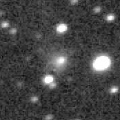
|
Now it is 16.0 mag (July 23, ATLAS-MLO, Mauna Loa). It is observable at 16 mag from 2020 to 2021. It locates low in the Southern Hemisphere.
Date(TT) R.A. (2000) Decl. Delta r Elong. m1 Best Time(A, h)
Aug. 21 22 24.57 42 51.1 5.435 6.067 124 16.3 0:29 (180, 82)
Aug. 28 22 17.11 41 53.8 5.400 6.077 128 16.3 23:49 (180, 83)
|

|
Now it is 16.0 mag (July 20, Thomas Lehmann). In the Northern Hemisphere, it stays observable for a long time while it is getting fainter slowly. In the Southern Hemisphere, it will never be observable again.
Date(TT) R.A. (2000) Decl. Delta r Elong. m1 Best Time(A, h)
Aug. 21 13 39.36 50 7.5 7.022 6.549 58 16.4 20:11 (129, 40)
Aug. 28 13 42.59 48 59.4 7.100 6.597 56 16.4 20:00 (128, 37)
|
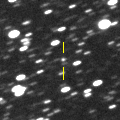
|
Now it is 16.1 mag (Aug. 2, F. Kugel, J.-G. Bosch). It is expected to brighten up to 11 mag from spring to summer in 2022. In the Southen Hemisphere, it locates somewhat low in 2021, but it will be observable in good condition at the high light for a long time. In the Northern Hemisphere, it is observable in good condition in 2021, but it will not be observable at the high light.
Date(TT) R.A. (2000) Decl. Delta r Elong. m1 Best Time(A, h)
Aug. 21 19 10.47 30 13.8 3.256 3.877 121 16.4 21:10 ( 0, 85)
Aug. 28 19 1.97 28 3.5 3.235 3.813 117 16.4 20:34 ( 0, 83)
|
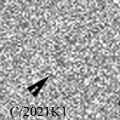
|
Now it is 15.9 mag (Aug. 2, ATLAS-MLO, Mauna Loa). It will be fading after this, and it will be fainter than 18 mag in November.
Date(TT) R.A. (2000) Decl. Delta r Elong. m1 Best Time(A, h)
Aug. 21 1 15.37 -7 26.8 1.928 2.709 131 16.4 3:19 ( 0, 48)
Aug. 28 1 16.36 -8 25.0 1.900 2.735 137 16.5 2:52 ( 0, 47)
|
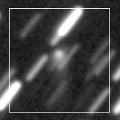
|
Now it is 16.1 mag (July 20, E. Bryssinck). It stays at 16-17 mag from 2020 to 2021. In the Northern Hemisphere, it stays observable in good condition for a long time. It locates extremely low in the Southern Hemisphere.
Date(TT) R.A. (2000) Decl. Delta r Elong. m1 Best Time(A, h)
Aug. 21 18 33.58 51 18.5 8.600 8.872 102 16.5 20:33 (180, 74)
Aug. 28 18 29.76 51 1.5 8.632 8.876 100 16.5 20:02 (180, 74)
|
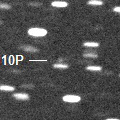
|
Now it is 18.0 mag (Aug. 1, Palomar Mountain--ZTF). Appearing in the morning sky. It will brightens rapidly. And it will be observable at 15 mag in excellent condition in winter.
Date(TT) R.A. (2000) Decl. Delta r Elong. m1 Best Time(A, h)
Aug. 21 6 31.62 28 1.0 2.990 2.482 51 16.7 3:53 (256, 31)
Aug. 28 6 45.00 27 37.2 2.917 2.476 54 16.5 4:00 (258, 35)
|

|
Announced as a bright Centaur-type asteroid. But Hidetaka Sato revealed that this is Phoebe, one of the satellites of Saturn.
Date(TT) R.A. (2000) Decl. Delta r Elong. m1 Best Time(A, h)
Aug. 21 20 46.86 -18 46.9 8.913 9.876 161 16.6 22:47 ( 0, 36)
Aug. 28 20 45.13 -18 54.2 8.960 9.878 153 16.6 22:18 ( 0, 36)
|

|
Now it is 19.4 mag (Aug. 12, Thomas Lehmann). It will brightens rapidly. And it is expected to be observable at 10-11 mag in good condition from December to February.
Date(TT) R.A. (2000) Decl. Delta r Elong. m1 Best Time(A, h)
Aug. 21 22 37.17 0 57.9 1.030 2.022 163 17.0 0:41 ( 0, 56)
Aug. 28 22 30.07 0 20.0 0.960 1.963 169 16.6 0:07 ( 0, 55)
|
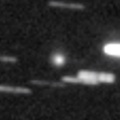
|
Now it is 16.8 mag (July 18, Toshihiko Ikemura, Hirohisa Sato). It is expected to brighten up to 11 mag in 2023. In the Northern Hemisphere, it is observable in good condition in 2021. But it is observable only until November in 2022. In the Southern Hemisphere, it locates extremely low in 2021. But it will be observable in good condition at the high light.
Date(TT) R.A. (2000) Decl. Delta r Elong. m1 Best Time(A, h)
Aug. 21 17 29.63 38 53.0 6.156 6.393 99 16.6 20:11 (117, 81)
Aug. 28 17 27.61 37 34.7 6.159 6.344 95 16.6 20:00 (106, 78)
|
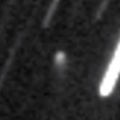
|
Now it is 17.1 mag (Aug. 2, ATLAS-HKO, Haleakala). It will brighten up to 15.5 mag in winter. In the Northern Hemisphere, it stays observable in good condition for a long time. It is not observable at all in the Southern Hemisphere.
Date(TT) R.A. (2000) Decl. Delta r Elong. m1 Best Time(A, h)
Aug. 21 16 43.30 72 49.2 3.377 3.379 81 16.6 20:11 (170, 51)
Aug. 28 16 22.22 71 39.2 3.363 3.346 80 16.6 20:00 (165, 50)
|
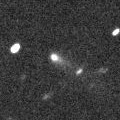
|
Now it is 16.6 mag (Aug. 12, Michael Jager). It stays observable at 16.5 mag in good condition until October.
Date(TT) R.A. (2000) Decl. Delta r Elong. m1 Best Time(A, h)
Aug. 21 23 31.08 -0 45.8 1.210 2.168 154 16.7 1:35 ( 0, 54)
Aug. 28 23 26.53 -0 15.8 1.184 2.168 162 16.6 1:03 ( 0, 55)
|

|
It stays observable at 16 mag from autumn to winter. In the Northern Hemisphere, it stays observable in good condition. In the Southern Hemisphere, it stays extremely low until November.
Date(TT) R.A. (2000) Decl. Delta r Elong. m1 Best Time(A, h)
Aug. 21 7 43.03 27 57.4 2.552 1.828 35 16.7 3:53 (247, 17)
Aug. 28 8 3.20 26 57.1 2.504 1.814 37 16.6 4:00 (250, 19)
|
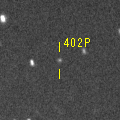
|
First return of a new periodic comet observed at 16 mag from 2003 to 2004. Now it is 16.8 mag (Apr. 11, J. Drummond). It will brighten up to 16 mag in winter, and it will be observable in excellent condition. It will be getting higher gradually.
Date(TT) R.A. (2000) Decl. Delta r Elong. m1 Best Time(A, h)
Aug. 21 6 1.14 2 22.5 4.402 3.993 59 16.7 3:53 (284, 23)
Aug. 28 6 7.57 2 17.2 4.315 3.987 64 16.7 4:00 (289, 29)
|
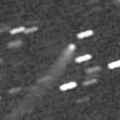
|
Now it is 16.5 mag (July 29, ATLAS-HKO, Haleakala). Fading slowly. In the Northern Hemisphere, it stays observable in good condition for a long time. It is not observable after this in the Southern Hemisphere.
Date(TT) R.A. (2000) Decl. Delta r Elong. m1 Best Time(A, h)
Aug. 21 16 23.13 54 13.9 5.659 5.633 83 16.7 20:11 (144, 63)
Aug. 28 16 19.13 53 24.1 5.733 5.666 81 16.8 20:00 (139, 61)
|
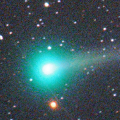
|
It brightened up to 3 mag in December in the SOHO spacecraft images (Dec. 18, Hirohisa Sato). Now it is 16.2 mag (July 22, ATLAS-MLO, Mauna Loa). It stays observable in good condition after this while the comet will be fading.
Date(TT) R.A. (2000) Decl. Delta r Elong. m1 Best Time(A, h)
Aug. 21 23 58.41 19 29.4 3.211 4.011 136 16.8 2:02 ( 0, 75)
Aug. 28 23 52.39 19 0.2 3.229 4.091 144 16.9 1:29 ( 0, 74)
|
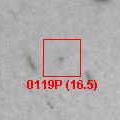
|
Now it is 18.9 mag (Aug. 3, ATLAS-HKO, Haleakala). It will brighten up to 14.5 mag in 2022 winter. In 2021, it stays observable in good condition while the comet will be brightening gradually. It is fainter than this ephemeris recently.
Date(TT) R.A. (2000) Decl. Delta r Elong. m1 Best Time(A, h)
Aug. 21 22 55.58 -15 50.7 2.258 3.249 166 16.9 1:00 ( 0, 39)
Aug. 28 22 50.94 -16 32.1 2.222 3.223 170 16.9 0:27 ( 0, 39)
|
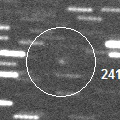
|
Now it is 17.3 mag (Aug. 2, F. Kugel, J.-G. Bosch). In the Northern Hemisphere, it stays observable at 17 mag in good condition until winter. In the Southern Hemisphere, it stays locating extremely low for a while.
Date(TT) R.A. (2000) Decl. Delta r Elong. m1 Best Time(A, h)
Aug. 21 6 31.36 37 25.5 2.369 1.934 52 17.2 3:53 (245, 35)
Aug. 28 6 50.72 36 52.7 2.331 1.944 55 17.2 4:00 (247, 37)
|
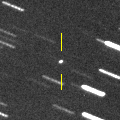
|
Now it is 17.6 mag (Aug. 2, F. Kugel, J.-G. Bosch). In the Northern Hemisphere, it stays observable in good condition after this while the comet will be fading. In the Southern Hemisphere, it stays locating extremely low for a long time.
Date(TT) R.A. (2000) Decl. Delta r Elong. m1 Best Time(A, h)
Aug. 21 4 50.76 35 5.2 2.521 2.422 72 17.2 3:53 (256, 53)
Aug. 28 4 59.74 35 55.9 2.492 2.477 77 17.3 4:00 (257, 59)
|
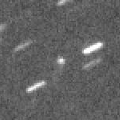
|
It will brighten up to 16 mag in 2022. In the Northern Hemisphere, it stays observable in good condition for a long time. In the Southern Hemisphere, it is not observable until 2023.
Date(TT) R.A. (2000) Decl. Delta r Elong. m1 Best Time(A, h)
Aug. 21 8 0.52 48 21.2 5.019 4.347 43 17.4 3:53 (227, 24)
Aug. 28 8 8.56 49 19.3 4.916 4.317 48 17.3 4:00 (228, 28)
|

|
It had been observed as 8-9 mag for a long time in 2020. Now it is fading. It has already faded down to 17.6 mag (July 29, J. Drummond). It will be observable in good condition after this in the Southern Hemisphere. It locates extremely low after this in the Northern Hemisphere.
Date(TT) R.A. (2000) Decl. Delta r Elong. m1 Best Time(A, h)
Aug. 21 16 7.77 -45 26.5 5.245 5.511 99 17.3 20:11 ( 21, 5)
Aug. 28 16 8.96 -45 19.1 5.410 5.572 94 17.4 20:00 ( 23, 4)
|
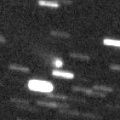
|
Now it is 16.6 mag (July 25, ATLAS-MLO, Mauna Loa). It will be fading after this, and it will be fainter than 18 mag in October.
Date(TT) R.A. (2000) Decl. Delta r Elong. m1 Best Time(A, h)
Aug. 21 15 10.97 -22 11.4 5.184 5.168 83 17.3 20:11 ( 44, 19)
Aug. 28 15 9.60 -22 37.0 5.332 5.192 76 17.4 20:00 ( 47, 16)
|
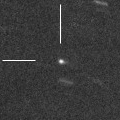
|
Now it is 17.5 mag (Aug. 12, Michael Jager). It is observable at 17 mag in good condition in autumn.
Date(TT) R.A. (2000) Decl. Delta r Elong. m1 Best Time(A, h)
Aug. 21 2 27.66 18 51.7 3.418 3.840 107 17.5 3:53 (330, 72)
Aug. 28 2 29.81 18 51.6 3.320 3.835 113 17.4 4:00 (356, 74)
|
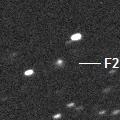
|
Now it is 17.7 mag (July 25, Michael Jager). It stays observable at 17-18 mag for a long time until 2024.
Date(TT) R.A. (2000) Decl. Delta r Elong. m1 Best Time(A, h)
Aug. 21 14 18.91 -5 19.6 9.375 9.021 66 17.5 20:11 ( 66, 22)
Aug. 28 14 18.90 -5 20.3 9.476 9.013 59 17.5 20:00 ( 69, 19)
|
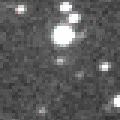
|
Now it is 17.0 mag (July 26, ATLAS-HKO, Haleakala)�$B!#�(BIt stays observable at 17-18 mag for a long time from 2021 to 2022.
Date(TT) R.A. (2000) Decl. Delta r Elong. m1 Best Time(A, h)
Aug. 21 19 5.66 -18 41.9 3.320 4.123 137 17.5 21:06 ( 0, 36)
Aug. 28 19 4.63 -18 47.3 3.388 4.117 130 17.5 20:38 ( 0, 36)
|
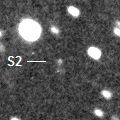
|
First return of a new periodic comet which brightened up to 17 mag in 2012. Now it is 18.3 mag (July 10, ATLAS-HKO, Haleakala). In the Southern Hemisphere, it is observable at 17.5 mag in excellent condition in summer. It locates low in the Northern Hemisphere.
Date(TT) R.A. (2000) Decl. Delta r Elong. m1 Best Time(A, h)
Aug. 21 19 32.67 -41 31.8 0.718 1.610 136 17.5 21:33 ( 0, 14)
Aug. 28 19 32.19 -41 22.3 0.712 1.569 130 17.5 21:06 ( 0, 14)
|
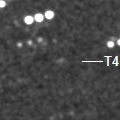
|
Now it is extremely faint as 20.5 mag (June 17, M. Jaeger, E. Prosperi, S. Prosperi). It was predicted to brighten up to 17.5 mag in 2021 summer. But actually, it is much fainter than predicted. It is not observable in the Southern Hemisphere.
Date(TT) R.A. (2000) Decl. Delta r Elong. m1 Best Time(A, h)
Aug. 21 13 26.70 58 1.3 2.588 2.258 59 17.6 20:11 (139, 39)
Aug. 28 13 43.90 53 39.2 2.630 2.278 58 17.7 20:00 (134, 38)
|

|
Now it is 16.4 mag (July 31, ATLAS-HKO, Haleakala). It will be fading slowly.
Date(TT) R.A. (2000) Decl. Delta r Elong. m1 Best Time(A, h)
Aug. 21 16 57.20 -11 0.2 7.622 7.961 106 17.7 20:11 ( 24, 41)
Aug. 28 16 55.24 -10 53.8 7.768 7.988 98 17.8 20:00 ( 30, 39)
|
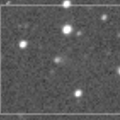
|
First return of a new periodic comet which brightened up to 17 mag in 2006. Now it is 17.4 mag (June 15, Taras Prystavski). It stays 18 mag from 2021 to 2022.
Date(TT) R.A. (2000) Decl. Delta r Elong. m1 Best Time(A, h)
Aug. 21 22 8.88 -69 36.7 2.606 3.264 122 17.7 0:14 ( 0,-15)
Aug. 28 21 58.35 -69 13.2 2.619 3.250 120 17.7 23:31 ( 0,-14)
|

|
It brightened up to 18.5 mag in 2020 spring (Apr. 2, 2020, W. Hasubick). Now it is 19.3 mag (July 16, J. P. Desgrees, J. L. Virlichie, P. Traverse, H. Roy). It has passed the perihelion in 2020 October. At the discovery in 2005, it stayed bright for several years even after the perihelion passage. In this apparition, it may stay observable at 18 mag from 2021 to 2024.
Date(TT) R.A. (2000) Decl. Delta r Elong. m1 Best Time(A, h)
Aug. 21 23 45.13 -27 6.7 2.960 3.878 151 17.7 1:49 ( 0, 28)
Aug. 28 23 41.88 -27 47.5 2.961 3.898 154 17.7 1:18 ( 0, 27)
|
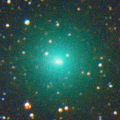
|
It brightened up to 8.2 mag in 2020 autumn (Oct. 13, 2020, Chris Wyatt). Now it is 18.9 mag (July 15, Palomar Mountain--ZTF). It is observable at 18 mag in 2021.
Date(TT) R.A. (2000) Decl. Delta r Elong. m1 Best Time(A, h)
Aug. 21 4 58.77 22 48.0 3.313 3.150 71 17.8 3:53 (273, 47)
Aug. 28 5 4.08 23 0.1 3.251 3.188 77 17.8 4:00 (278, 53)
|
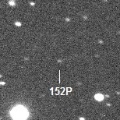
|
Now it is 17.7 mag (July 13, ATLAS-MLO, Mauna Loa). It will brighten up to 16 mag in 2022. In 2021, it stays observable at 18 mag until September.
Date(TT) R.A. (2000) Decl. Delta r Elong. m1 Best Time(A, h)
Aug. 21 14 1.56 -5 35.5 3.530 3.193 62 17.8 20:11 ( 68, 19)
Aug. 28 14 9.12 -6 35.2 3.603 3.184 57 17.8 20:00 ( 69, 16)
|

|
It stays 17 mag for a long time from 2021 to 2022. It is observable in excellent condition in the Northern Hemisphere, It locates somewhat low in the Southern Hemisphere.
Date(TT) R.A. (2000) Decl. Delta r Elong. m1 Best Time(A, h)
Aug. 21 5 39.38 31 48.4 6.011 5.618 62 17.9 3:53 (257, 43)
Aug. 28 5 38.51 32 4.9 5.876 5.603 69 17.8 4:00 (260, 50)
|

|
Appearing in the morning sky. It will brighten up to 15.5 mag, and will be observable in excellent condition in winter.
Date(TT) R.A. (2000) Decl. Delta r Elong. m1 Best Time(A, h)
Aug. 21 7 20.44 19 47.0 2.784 2.097 39 18.0 3:53 (257, 17)
Aug. 28 7 36.92 19 22.3 2.722 2.082 41 17.9 4:00 (260, 21)
|
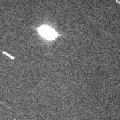
|
First return of a new periodic comet observed at 17 mag in 2014. It has not been observed yet in this apparition. The orbital elements are improved based on the new observations from June to July in 2014, and the perihelion date moved about 1 month earlier. It is expected to brighten up to 18 mag in summer, and it will be observable in good condition.
Date(TT) R.A. (2000) Decl. Delta r Elong. m1 Best Time(A, h)
Aug. 21 3 36.63 29 34.8 1.638 1.911 89 17.9 3:53 (276, 67)
Aug. 28 3 46.43 30 30.8 1.600 1.942 93 17.9 4:00 (279, 72)
|
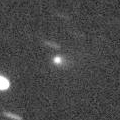
|
First return of a new periodic comet which brightened up to 16 mag in 2014. It brightened up to 16.0 mag in spring (Apr. 4, Sandor Szabo). Now it is fading. It will be fainter than 18 mag soon.
Date(TT) R.A. (2000) Decl. Delta r Elong. m1 Best Time(A, h)
Aug. 21 13 50.53 -16 1.3 2.404 2.154 63 17.9 20:11 ( 62, 10)
Aug. 28 14 3.17 -17 39.2 2.475 2.160 60 18.0 20:00 ( 61, 8)
|

|
Now it is 18.6 mag (Aug. 3, ATLAS-HKO, Haleakala). It will brighten up to 16.5-17 mag in winter. In its last apparition in 2015, it brightened up to 13 mag.
Date(TT) R.A. (2000) Decl. Delta r Elong. m1 Best Time(A, h)
Aug. 21 22 18.34 -28 33.8 1.501 2.487 163 18.0 0:23 ( 0, 27)
Aug. 28 22 11.98 -29 50.0 1.472 2.444 159 17.9 23:44 ( 0, 25)
|
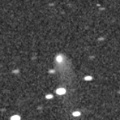
|
It brightened up to 13.8 mag in autumn in 2019 (Sept. 3, 2019, Chris Wyatt). Now it is fading slowly. It stays 18 mag until autumn.
Date(TT) R.A. (2000) Decl. Delta r Elong. m1 Best Time(A, h)
Aug. 21 0 42.85 21 53.3 7.680 8.335 127 17.9 2:46 ( 0, 77)
Aug. 28 0 40.35 22 4.4 7.643 8.377 134 18.0 2:16 ( 0, 77)
|
|
![]()
 104P/Kowal 2
104P/Kowal 2 C/2020 K1 ( PanSTARRS )
C/2020 K1 ( PanSTARRS ) C/2021 D2 ( ZTF )
C/2021 D2 ( ZTF ) 193P/LINEAR-NEAT
193P/LINEAR-NEAT 52P/Harrington-Abell
52P/Harrington-Abell 402P/2020 Q3 ( LINEAR )
402P/2020 Q3 ( LINEAR ) C/2019 K7 ( Smith )
C/2019 K7 ( Smith ) C/2020 S3 ( Erasmus )
C/2020 S3 ( Erasmus ) 119P/Parker-Hartley
119P/Parker-Hartley 241P/LINEAR
241P/LINEAR 28P/Neujmin 1
28P/Neujmin 1 C/2020 U5 ( PanSTARRS )
C/2020 U5 ( PanSTARRS ) C/2017 T2 ( PanSTARRS )
C/2017 T2 ( PanSTARRS ) C/2017 Y2 ( PanSTARRS )
C/2017 Y2 ( PanSTARRS ) P/2021 N2 ( Fuls )
P/2021 N2 ( Fuls ) C/2020 F2 ( ATLAS )
C/2020 F2 ( ATLAS ) 395P/2020 H1 ( Catalina-NEAT )
395P/2020 H1 ( Catalina-NEAT ) 424P/2021 L5 ( La Sagra )
424P/2021 L5 ( La Sagra ) C/2020 T4 ( PanSTARRS )
C/2020 T4 ( PanSTARRS ) C/2017 U7 ( PanSTARRS )
C/2017 U7 ( PanSTARRS ) 422P/2021 L1 ( Christensen )
422P/2021 L1 ( Christensen ) 378P/2019 E2 ( McNaught )
378P/2019 E2 ( McNaught ) 88P/Howell
88P/Howell 152P/Helin-Lawrence
152P/Helin-Lawrence C/2020 U4 ( PanSTARRS )
C/2020 U4 ( PanSTARRS ) 70P/Kojima
70P/Kojima P/2014 W12 ( Gibbs )
P/2014 W12 ( Gibbs ) 413P/2020 W4 ( Larson )
413P/2020 W4 ( Larson ) 230P/LINEAR
230P/LINEAR C/2017 B3 ( LINEAR )
C/2017 B3 ( LINEAR )![]()




































































